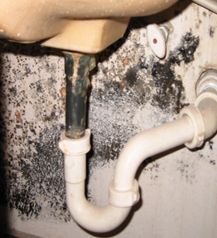Signs of Mold in House
Below are some common signs to watch out for that could indicate you have mold growing in your house.Allergic Symptoms from Mold
If you are having a problem with allergies then there's a good chance there could be mold growing somewhere in your home. Common allergic reactions to mold include sneezing, sore eyes and a runny nose or nasal congestion.
Do you notice your allergic reactions are worse when you're at home but you feel better when you go out? If so then it's especially likely you could have mold. If you find that your allergies are worse in some other building, like your workplace, then there could be mold growing there instead.
Smelling a Mold Odor
When you have mold growing hidden away in your house, often a moldy smell might be the only clue that it's there. Don't ignore mold odors if you can't see any mold. You should thoroughly inspect your home before any mold problems get worse.Seeing Signs of Mold Growth
Visible mold growth might seem like an obvious sign of mold. However many people don't notice small amounts of mold growth or they think it's just soot or dirt. Sometimes people simply ignore visible mold in their house.If you can see mold growth, even if it's only small, you should take action immediately. Small mold patches can spread and the fact that there is any mold shows that the conditions in your home are right for mold to grow.
If you don't take care of mold it will soon become a bigger problem. Visible mold growth could also be a sign that there is a much larger mold colony growing hidden away from view.
Sometimes you might not realize there is mold in your house, especially if it is unusual looking mold. Some mold growth looks white and thread-like. Other mold appears as clusters of small black spots. Mold can be black, gray-brown, gray-green or white in color. Mold growing behind wallpaper made of vinyl can even appear orange, pink or purple.
Signs of Water Problems
If you have had any long term moisture problems in your house it's usually inevitable they will lead to mold beginning to grow. So if you know you've had some water problems in your home then it's a pretty good sign you could have mold.
Some signs that you have a moisture problem include water stains or discoloration on walls, floors or ceilings in your house. Seeing these could be a clue that there is mold growing within or behind the material.
Another sign of a moisture problem is surface abnormalities like peeling, bubbling or cracking of the paint or wallpaper. If your walls are bowed, bulging or warped it probably means moisture has gotten into them. Another clue is if the surface of walls or other materials feel damp.
Water Leaks

Mold growth from leaks can often be hidden. If the leak was behind a wall or other surface then any mold will probably be hidden behind the surface too. Even if the leak was not behind a surface there could still be mold hidden out of view behind a wall or other surface from water which seeped through.
Toxic Symptoms from Mold
If you suffer neurological symptoms such as headaches, trouble concentrating, shortened attention span, memory loss and dizziness it could be a sign that there is toxic mold growing somewhere in your house which is poisoning you.Mycotoxins from toxic molds such as Stachybotrys chartarum can have a mental effect on people much more severe than the allergic symptoms caused by other non-toxic molds.
Like with allergies, if toxic symptoms increase when you are in your home or in a certain building then it's very likely that mold is growing there.
Reference: http://blackmold.awardspace.com/mold-signs.html
